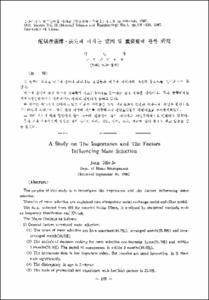드라이아이스 제조 사이클에서 중간압력과 압축기효율에 따른 압축동력의 거동
- Alternative Title
- Behavior of Compression Power due to Changes in the Intermediate Pressure and Compressor Efficiency in a Dry Ice Production Cycle
- Abstract
- 지구온난화의 주범이 되고 있는 대기 중의 이산화탄소량을 감소시키기 위한 방법 중의 하나로, 화석연료의 연도가스나 화학공정의 부산물로부터 이산화탄소를 분리하고 이를 드라이아이스로 만들어 필요한 곳에 사용하는 방법이 제시될 수 있다. 이 드라이아이스 제조 과정에서 압축동력을 최소화하는 것은 발전소의 생산전력을 줄일 수 있으므로 대기 중의 이산화탄소량을 감소시키는 상승작용을 가져오게 된다. 본 연구에서는 중간냉각기가 있는 3단 압축시스템으로 된 드라이아이스 제조 사이클에서 중간압력의 변화에 대한 압축동력의 거동을 시뮬레이션을 통하여 조사하고 이로부터 압축기효율이 최소압축동력에 미치는 영향을 분석하였다. 이 사이클에서 이산화탄소는 냉매로서 또 드라이아이스의 원료로서 사용된다. 최소압축동력에 대응하는 최적의 중간압력은 기존의 등압력비로 계산된 값과 큰 차이가 있음이 밝혀졌다. 이는 압축기 각 단의 유입유량이 동일한 경우와 달리, 중간냉각에 의해 증발된 플래쉬 가스의 유량이 중간압력의 증가에 따라 거의 선형적으로 증가하기 때문이다. 아울러 압축기효율이 최소압축동력에 큰 영향을 미침을 알 수 있었다.
For the purpose of reducing indirectly the CO₂concentration in the air, a reduction of the compression power required in the process of dry ice production was proposed because minimizing compression power can lead to lower emissions of CO₂from the power plants. In this study, a dry ice production cycle composed of three-stage compression system with both flash drums and intercoolers is simulated to find the minimum compression power and its trend as a function of compressor efficiency. In this cycle, CO₂is used both as refrigerant and as the raw material for dry ice. The power required for the compression process is investigated in terms of the flash drum pressure and compressor efficiency. It is of major concern to find minimum compression power and the corresponding optimum flash drum pressure. Result shows that the optimum pressure is not consistent with the conventional pressure obtained from the equal pressure ratio assumption. This is mainly due to the change in mass flow rate of the intermediate stage compressor by flash gas evaporation from the flash drums. Most important is that compressor efficiency has a remarkable effect on the minimum compression power.
For the purpose of reducing indirectly the CO₂concentration in the air, a reduction of the compression power required in the process of dry ice production was proposed because minimizing compression power can lead to lower emissions of CO₂from the power plants. In this study, a dry ice production cycle composed of three-stage compression system with both flash drums and intercoolers is simulated to find the minimum compression power and its trend as a function of compressor efficiency. In this cycle, CO₂is used both as refrigerant and as the raw material for dry ice. The power required for the compression process is investigated in terms of the flash drum pressure and compressor efficiency. It is of major concern to find minimum compression power and the corresponding optimum flash drum pressure. Result shows that the optimum pressure is not consistent with the conventional pressure obtained from the equal pressure ratio assumption. This is mainly due to the change in mass flow rate of the intermediate stage compressor by flash gas evaporation from the flash drums. Most important is that compressor efficiency has a remarkable effect on the minimum compression power.
- Issued Date
- 1998
- Type
- Research Laboratory
- Alternative Author(s)
- Lee, Geun Sik
- Publisher
- 공학연구논문집
- Language
- kor
- Rights
- 울산대학교 저작물은 저작권에 의해 보호받습니다.
- Citation Volume
- 29
- Citation Number
- 2
- Citation Start Page
- 605
- Citation End Page
- 613
- Appears in Collections:
- Research Laboratory > Engineering Research
- 파일 목록
-
-
Download
 000002024179.pdf
기타 데이터 / 904.62 kB / Adobe PDF
000002024179.pdf
기타 데이터 / 904.62 kB / Adobe PDF
-
Items in Repository are protected by copyright, with all rights reserved, unless otherwise indicated.